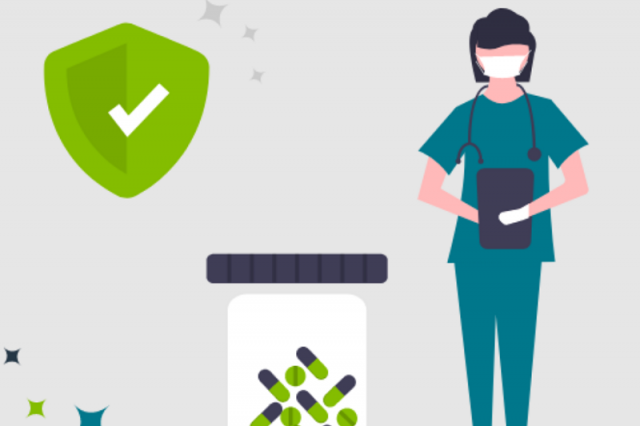Medication mix-ups happen most in the first weeks of care. Names sound alike. Bottles look alike. Doses change. The fix is simple: one station, one routine, and a few safety checks you follow every time. This guide shows you how to set it up today.
Quick Answer
- One med station in a fixed spot
- Weekly pill organizer filled by one person, verified by a second
- Labeled alarms + a short written log near the station
- High-risk meds flagged (card + color cue)
- 24-hour emergency kit ready
- Red flags list posted with who to call
Start Here—Build One “Med Station” (10–20 minutes)
Location: quiet, well-lit, waist-height surface, away from heat, pets, and food prep.
What to include
- Small tray/bin to corral items
- Weekly pill organizer (large-print if possible)
- Water bottle/cups, pen, highlighter
- One-page log on a clipboard
- Simple timer or phone
Label layout (example)
- Top shelf: Morning | Noon | Evening | Bedtime
- Back row: current bottles only (extras stored elsewhere)
- Front row: weekly organizer aligned to time-of-day
Safety basics
- Childproof storage if kids visit
- Bright task light + night light on path to station
- No step stools (keep supplies at waist height)
Vision/hearing tips
- Large-print labels; high-contrast stickers on organizer
- Vibrating/visual alarms if hearing is limited
Cognition tips
- One person “owns” the system; keep directions printed at the station
- Reduce clutter: only current meds visible
The Weekly Fill (10–15 minutes)
Do it the same day and time each week (e.g., Sundays 4 p.m.). One person fills; a second can verify for complex regimens.
3-check method
- Bottle: name + strength
- Dose: confirm with the written med list
- Slot: place in correct day/time
Verification script (15 seconds):
- Filler: “Metoprolol 25 mg, morning, one tablet.”
- Verifier: “Confirmed: metoprolol 25 mg, morning, one.”
Sync & labels
- Ask pharmacy for sync fills (one refill date) and large-print labels
- Keep a sticky note of refill dates on the clipboard
For a deeper walkthrough, see managing medications at home (setups that actually work).
Daily Routine That Prevents Misses (5 minutes/day)
Pair doses with anchors you never skip: breakfast, lunch, dinner, bedtime.
Set alarms with clear labels: “Breakfast meds now.” Leave alarms on until logged.
Log quickly (first 1–2 weeks; longer if memory is an issue)
- Date | time | ✔ taken | short note (e.g., “mild nausea”)
Missed dose rule: follow the bottle or prescriber's instructions. Do not double up unless told to.
Refill rule: when any bottle hits 7 days left, request a refill and note the date.
High-Risk Meds & Simple Safety Checks
Examples: blood thinners (warfarin, apixaban), insulin, opioids, seizure meds, heart-rhythm meds.
Make a High-Risk Card (keep at the station)
- Med name + dose
- What to watch for (e.g., bleeding, low blood sugar)
- Who to call first (pharmacist/prescriber) + phone number
Color cues: put a colored sticker on high-risk bottles and matching organizer slots.
Keep a current med list
- Name | dose | time | purpose | prescriber | pharmacy phone
- Update the list the same day any change happens.
Look-Alike / Sound-Alike Watchlist (common mix-ups)
- Hydralazine / Hydroxyzine
- Metoprolol / Metoclopramide
- Glipizide / Glyburide
- Sertraline / Seroquel
- Warfarin 1 mg vs. 10 mg (check color/number)
Tip: Store look-alikes on separate sides of the tray and highlight labels.
Bathroom & Layout Tweaks That Reduce Errors
- Bright task lighting at the station; night lights to bathroom/bedroom
- Clear floors; remove loose rugs; stable chair nearby if dizzy
- Store daily items at waist height; avoid top/bottom shelves
More quick wins (grab bars, raised seats, non-slip mats, lighting) in bathroom modifications for safety and accessibility.
When Regimens Change (Hospital Stay, New Rx)
Brown-bag review (5–10 minutes)
- Gather all bottles
- Compare to discharge/new med list
- Remove stopped meds from the station
- Call pharmacist for interaction/duplicate checks
- Update the written med list and organizer today
Script: “We have a new discharge list. Can you help reconcile duplicates and check for interactions?”
Travel, Outings, and Backup Plans
- Daily wallet: pre-pack the day's doses in a labeled case
- Mini med list in wallet/phone (photo works)
- 24-hour emergency kit at home: spare doses, med list, prescriber numbers, small cash for a ride
- Cold-chain meds: small insulated pouch + ice pack as needed
Care Team Communication (Simple & Fast)
- Share the one-page med list at visits
- Bring the weekly log; patterns explain symptoms
- Pharmacist first for side effects, interactions, cost/supply issues
- Ask about blister packs or dose-pouch packaging if dexterity/cognition is limited
Mini-Guides for Common Med Situations
Diabetes (oral meds & insulin)
- Check meal timing; many oral meds go with food
- Insulin: store unopened pens/vials per label; opened at room temp if allowed; never reuse needles
- Watch for low blood sugar: sweating, shaking, confusion → follow the prescribed hypoglycemia plan
Blood thinners
- Warfarin: keep diet consistent (vitamin K foods), track INR per clinician
- DOACs (e.g., apixaban): take as scheduled; don't skip; watch for unusual bruising/bleeding
Blood pressure & heart meds
- Take at the same time daily; don't stop suddenly
- Stand up slowly; note dizziness in the log
Thyroid (levothyroxine)
- Take in the morning on an empty stomach, water only; wait 30–60 minutes before food/coffee
Antibiotics
- Finish the full course; note any rash, swelling, or breathing trouble (allergy red flags)
Inhalers
- Use spacer if prescribed; rinse mouth after steroid inhalers to prevent thrush
Simple Home Monitoring (helps explain symptoms)
- Blood pressure cuff: seated, feet flat, arm at heart level, rest 5 minutes before reading
- Blood sugar (if prescribed): log time relative to meals, value, and symptoms
- Bring 3–5 days of readings to telehealth or office visits
Dementia-Friendly Tweaks
- Keep only today's organizer row visible; hide the rest
- Use picture labels (sunrise/morning, moon/bedtime)
- Avoid multiple “yes/no” choices at once; one step at a time
- If refusals happen, pause and try again later with a calm tone
Multi-Caregiver Coordination (keeps everyone aligned)
- One printed med list on the clipboard + a shared phone note
- Initial the daily log after each dose
- End-of-shift text template: “All doses ✔. Noted [symptom]. Refill requested for [med].”
Red Flags—Call for Help
- Missed or double dose of a high-risk medicine
- New confusion/fainting; severe bleeding/bruising
- Chest pain, severe shortness of breath
- Very low/high blood sugar
- Sudden swelling, rash, wheeze, or trouble breathing (possible allergy)
Who to call:
- Pharmacist for dosing/interaction questions
- Prescriber for symptoms or changes
- Urgent care/911 for emergencies
Post this list near the station with phone numbers.
Templates & Tools (Copy/Paste)
One-Page Med List
Name | Dose | Time | Purpose | Prescriber | Pharmacy Phone
Daily Log
Date | Time | Dose ✔ | Notes (symptoms/side effects)
Weekly Fill Checklist
□ All current bottles present
□ Organizer filled with 3-check method
□ Second-person verification (if used)
□ High-risk card reviewed/updated
□ Refills requested (7-day rule)
Troubleshooting (fast fixes)
- Still missing doses? Move the station, add brighter light, simplify to two daily times if safe (ask prescriber), keep logging.
- Too many alarms? Limit to major anchors (breakfast/bedtime) and keep labels clear.
- Dexterity issues? Ask pharmacy for blister packs or easy-open caps (if safe).
- Anxiety about errors? Switch to unit-dose packaging or request home delivery/sync fill.
Quick Recap
- One station, one organizer, one weekly fill time prevents most errors.
- Alarms + a tiny log catch misses early.
- Flag high-risk meds and separate look-alikes.
- Bright lighting, clear paths, waist-height storage improve safety. Keep a current med list and lean on your pharmacist for fast help.






